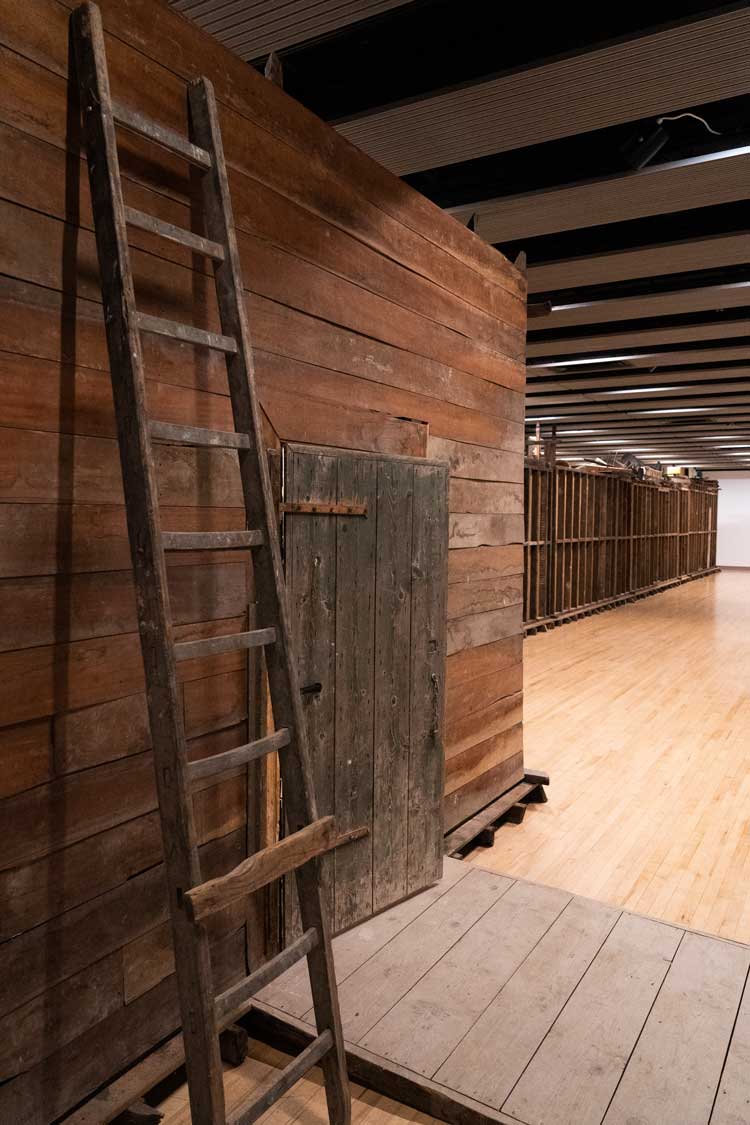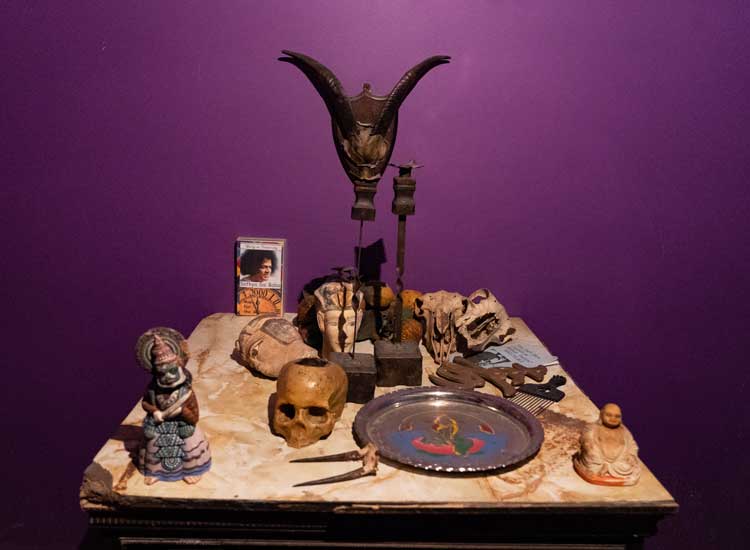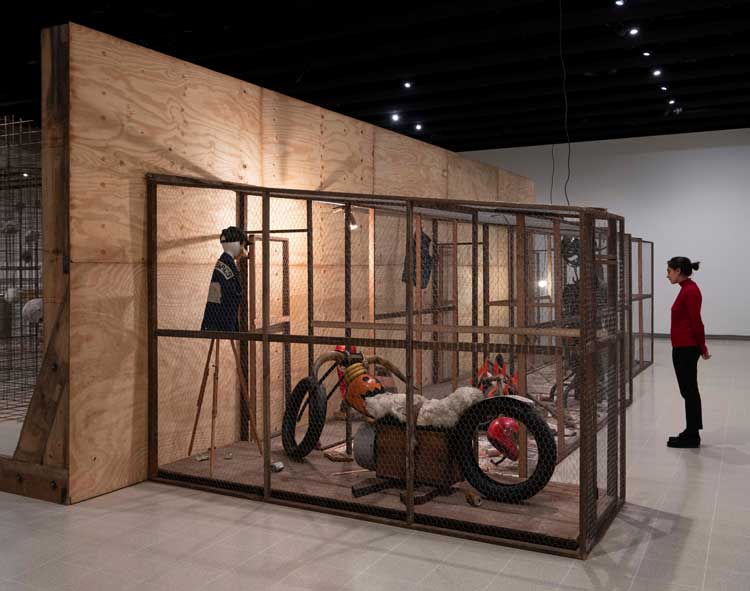

,-2004-8.jpg)
Installation view of Mike Nelson, Triple Bluff Canyon (the woodshed), 2004. Various materials. M25, 2023. Found tyres. Photo: Matt Greenwood. Courtesy the artist and the Hayward Gallery.
Hayward Gallery, London
22 February – 7 May 2023
by JOE LLOYD
In recent years, the Tate Britain’s Duveen Gallery has arguably overtaken the Tate Modern’s Turbine Hall as London’s prime venue for spectacular contemporary installations, and Mike Nelson’s The Asset Strippers (2019) was the best of them all. Nelson (b1967, Loughborough) filled the lengthy neoclassical throughway with machines from East Midlands factories, bought in online liquidation sales.
Tate Britain became a graveyard for the industrial past, with heavy air – some critics might say heavy-handed – and a distinctive metallic tang. These redundant machines spoke to a world of labour now lost, composing a requiem for the age of manufacturing long since declined. Despite the machines’ importance in Britain’s postwar economy, I (and I imagine many others at the exhibition) had little clue of how any of these machines functioned. Knowledge that was once crucial has been lost.
,-2019-6.jpg)
Mike Nelson, Triple Bluff Canyon (the woodshed), 2004. Photo: Matt Greenwood. Courtesy the artist and the Hayward Gallery.
A handful of these machines appear in Extinction Beckons, Nelson’s new survey exhibition at the Hayward Gallery. Given room to breathe, here they become even more sculptural: one machine looks like a reclining nude, another like a sort of Moai. But while their Tate debut was almost oppressively funereal, here they serve as something of a respite after a series of works of astonishing bleakness. Untitled (Public Sculpture for a Redundant Space) (2016) comprises a sleeping bag filled with rubble and concrete from a building site. It lays corpse-like on the Hayward’s tiled floor, next to a piece of wood resembling a crucifix, a brutal symbol of London’s relentless development. Extinction indeed seems to beckon.
,-2011.jpg)
Mike Nelson, I, Imposter (the darkroom), 2011. Various materials. Installation view. Photo: Matt Greenwood. Courtesy the artist and the Hayward Gallery.
Mercifully, Nelson’s art manages the rare trick of being both thoughtful and spectacular. His best works forestall the despair with awe. We begin in near darkness. The text describing I, Imposter (2021) is almost impossible to read. But it doesn’t matter too much. One turns a corner into a room lit with an unearthly crimson light. The Hayward’s project space has been turned into a storeroom for the components of the original 2011 I, Imposter, a sculptural installation presented at that year’s Venice Biennale, which itself reused parts of an installation shown at the 2003 Istanbul Biennial. There are all sorts of bits and bobs: a bucket of rusty nails, a spinning contraption, a door with a symbol resembling an incomplete Star of David, and a whole load of wooden planks. The work has an odd circularity: from scrap objects to artwork, to scrap objects in storage and back to artwork. It also serves as a starting point for an exhibition that seeks to breathe new life into an assortment of older works.

Mike Nelson, The Deliverance and The Patience, exterior, 2001. Various materials. Installation view. Photo: Liam Harrison. Courtesy the artist and the Hayward Gallery.
After working one’s way through this dismantled installation, we then encounter one that has been reassembled: The Deliverance and the Patience (2001). At the press view, the Hayward director, Ralph Rugoff, called this exhibition “the most technically challenging show the gallery has ever witnessed”, and this work is probably a large part of the reason why. First erected during the 2001 Venice Biennale, this is a labyrinth of MDF that fills the majority of the Hayward’s ground floor. Named after a 17th-century shipwreck whose survivors tried to create a new society in Bermuda, it images the lair created by a similar band of pirates.

Mike Nelson, The Deliverance and The Patience, interior, 2001. Installation view. Photo: Liam Harrison. Courtesy the artist and the Hayward Gallery.
Visitors must make their way through a forking path of battered corridors, pushing through doors to enter various rooms. These include a sleeping room with mattresses, a shrine, two bars and a travel agent, all fitted out with bits of scrap and antique objects. It is difficult to place in time and space, littered with furniture, objects and artefacts. At the time of the work’s creation, Nelson tells me, he was reading The Many-Headed Hydra (2000) – Marxist historian Peter Linebaugh’s account of the dispossessed in the early modern Atlantic, filled with tales of pirate islands – as well as the experimental fiction of William S Burroughs and Hakim Bey. The Deliverance and the Patience represents an attempt to, Nelson says, “equate a literary structure to a spatial structure”, to present a space where ideas associations drift and bump together.
There are no people left in Nelson’s settlement, but there are traces. A jacket left on a bar stool, an upturned chair: it seems like the society that had been created was swiftly abandoned, possibly under duress. Many of the other pieces in the exhibition tell the stories of missing people. I, Imposter: The Darkroom (2011), a fragment of the Venice-via-Istanbul piece, is a photographer’s darkroom hidden beneath a mound of sand. This fragment of desert is itself an earlier work, Triple Bluff Canyon (The Woodshed) (2004). It references Robert Smithson’s Partially Buried Woodshed (1970) at Kent State University in Ohio, which gained political relevance after the National Guard killed four peaceful anti-Vietnam protesters on campus a few months after it was unveiled. Nelson’s work summons the fictional ghosts who lived inside his woodshed and the very real spectre of Smithson’s work, while evoking the Iraq war that raged at the time of its construction.

Mike Nelson, The Amnesiacs, 1996-ongoing. Installation view. Photo: Matt Greenwood. Courtesy the artist and the Hayward Gallery.
Sometimes Nelson is more playful, but the ghosts still come with a heavy burden. The Amnesiacs (1996-) is a project imagining a biker gang of Gulf war veterans whose post-traumatic stress disorder causes them to experience flashbacks. Presented here as a caged installation featuring comically masked figures, it draws parallels with Nelson’s own habit of taking discarded items and materials and presenting their stories. He himself is the spectre in Triple Bluff Canyon (the projection room) (2004), a full-scale reconstruction of Nelson’s former studio in the front room of a Victorian terraced house, littered with secondhand paperbacks, furniture, tools and assorted paraphernalia.
A projector shines out of this man-cave to the wall beyond and shows a grotesquely enlarged slideshow lecture by a rightwing American conspiracy theorist who constructs a myth through signs and symbols. In mocking this deplorable’s delusional narrative, Nelson might also be casting a wry eye over his own work. He, too, compounds debris into stories and characters. And confronted with his work, so do we all.